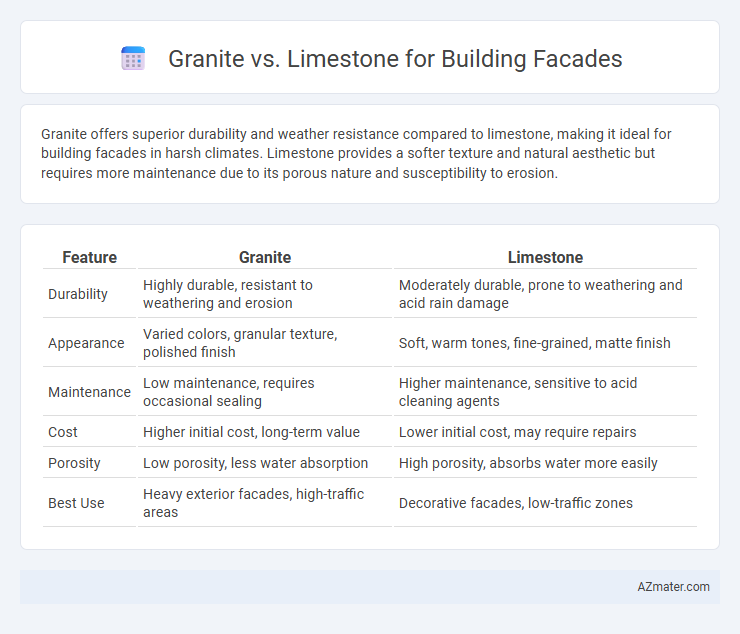Granite offers superior durability and weather resistance compared to limestone, making it ideal for building facades in harsh climates. Limestone provides a softer texture and natural aesthetic but requires more maintenance due to its porous nature and susceptibility to erosion.
Table of Comparison
| Feature | Granite | Limestone |
|---|---|---|
| Durability | Highly durable, resistant to weathering and erosion | Moderately durable, prone to weathering and acid rain damage |
| Appearance | Varied colors, granular texture, polished finish | Soft, warm tones, fine-grained, matte finish |
| Maintenance | Low maintenance, requires occasional sealing | Higher maintenance, sensitive to acid cleaning agents |
| Cost | Higher initial cost, long-term value | Lower initial cost, may require repairs |
| Porosity | Low porosity, less water absorption | High porosity, absorbs water more easily |
| Best Use | Heavy exterior facades, high-traffic areas | Decorative facades, low-traffic zones |
Introduction to Building Facade Materials
Granite and limestone are two popular materials used for building facades due to their durability and aesthetic appeal. Granite offers exceptional hardness, weather resistance, and a wide range of colors, making it ideal for high-traffic or exposed environments. Limestone provides a softer, more porous texture with natural earthy tones, often preferred for classical or traditional architectural styles.
Overview: Granite vs Limestone
Granite is a dense, igneous rock known for its durability, hardness, and resistance to weathering, making it ideal for building facades requiring long-lasting strength. Limestone, a sedimentary rock composed mainly of calcium carbonate, offers a softer, more porous surface with a classic, warm appearance but requires more maintenance and protection against acid rain and erosion. Both materials provide distinct aesthetic and functional qualities, with granite favored for high-traffic, exposed locations and limestone chosen for ornate, historic, or lighter architectural designs.
Aesthetic Appeal and Color Range
Granite offers a rich aesthetic appeal with its natural crystalline texture and a broad color spectrum that ranges from deep blacks and grays to vibrant reds and pinks, making it ideal for dynamic building facades. Limestone provides a softer, more uniform appearance with earth-toned hues such as creamy whites, beiges, and light grays, lending a classic and timeless elegance to architectural designs. The choice between granite and limestone significantly influences the visual impact and style of a building's exterior, balancing boldness and subtlety through their distinct color ranges and textures.
Durability and Weather Resistance
Granite offers superior durability and weather resistance compared to limestone, making it ideal for building facades exposed to harsh climates and environmental stressors. Its dense, non-porous composition resists erosion, moisture infiltration, and freeze-thaw cycles far better than the softer, more porous limestone. Limestone, while aesthetically pleasing, requires frequent maintenance to protect against weathering, acid rain, and surface erosion in exterior architectural applications.
Maintenance Requirements
Granite requires minimal maintenance for building facades due to its dense, non-porous surface, making it highly resistant to staining, weathering, and microbial growth. Limestone, being a softer and more porous material, demands regular sealing and cleaning to prevent erosion, discoloration, and damage from acid rain and pollutants. Proper upkeep of limestone facades includes periodic inspections and timely repairs to maintain structural integrity and aesthetic appeal.
Structural Strength and Weight
Granite offers superior structural strength with a compressive strength ranging from 100 to 250 MPa, making it highly durable for building facades in demanding environments. Limestone, with a compressive strength typically between 30 to 250 MPa, is generally softer and lighter, weighing approximately 160 to 185 pounds per cubic foot compared to granite's denser 168 to 176 pounds per cubic foot. The higher density and strength of granite provide greater resistance to weathering and impact, making it ideal for high-load and long-lasting facade applications.
Cost Comparison
Granite typically costs between $50 to $200 per square foot installed, making it a more expensive option compared to limestone, which ranges from $40 to $100 per square foot. The higher price of granite is due to its durability, low maintenance, and resistance to weathering, offering better long-term value. Limestone requires more upkeep and is prone to erosion, leading to potentially higher maintenance costs over time despite its lower initial price.
Environmental Impact and Sustainability
Granite offers durability and low porosity, reducing the need for frequent maintenance and minimizing environmental emissions associated with repairs, whereas limestone, being more porous, may require sealing and more upkeep, increasing its carbon footprint over time. Quarrying granite typically consumes more energy due to its hardness, but its longevity and recyclability enhance its sustainability profile compared to limestone, which is easier to extract but less resistant to weathering. Choosing granite for building facades aligns with sustainable architecture by maximizing lifespan and reducing resource consumption, while limestone's eco-benefits depend heavily on responsible sourcing and protective treatments.
Installation Process Differences
Granite installation for building facades requires heavy machinery and precise anchoring due to its dense composition and significant weight, often involving mechanical fasteners or metal brackets for secure attachment. Limestone, being softer and lighter, allows for easier cutting and handling, enabling installation with mortar or adhesive systems, but requires careful protection from moisture during the curing process to prevent damage. Understanding these material-specific installation techniques ensures structural integrity and long-term facade performance.
Best Applications for Granite and Limestone Facades
Granite is ideal for building facades requiring exceptional durability, weather resistance, and a high-end aesthetic due to its dense composition and natural hardness, making it suitable for commercial and high-traffic urban structures. Limestone offers a softer, porous surface with warm, natural tones that excel in historic restorations and facades emphasizing classic elegance but may require more maintenance in harsh climates. Choosing granite suits modern architectural designs prioritizing longevity and low maintenance, while limestone is preferred for decorative facades with intricate carvings and a timeless appearance.

Infographic: Granite vs Limestone for Building Facade
 azmater.com
azmater.com